




BO'NESS INDUSTRIAL CO-OPERATIVE POTTERY AND MANUFACTURING SOCIETY LIMITED
At a meeting of the towns Police Commission on Monday, 12th December 1887, a letter from Mr Crosthwaite, Grange Road was read.
Henry Crosthwaite was the secretary of the Boness Industrial Pottery and Manufacturing Society Limited.
In his letter he explained that as a result of the Society considering the building of a pottery in the Grangepans district of the town, it
was appealing to the Commission to consider supplying water for manufacturing purposes in that water district at a rate the same as
supplied to manufacturers in the town proper.
A few months after the water rate appeal, advertisements for shares started to appear in the press.

In March 1889, at their first general meeting in Clarence Street Hall, Glasgow (below left), shareholders unanimously agreed to accept
the site in Grangepans offered by Mr Henry Moubray Cadell of Grange (below right).
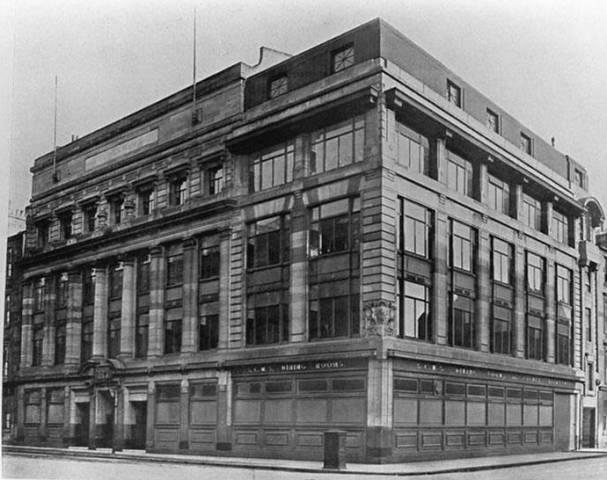

On Saturday, 25th January 1890, around 40 shareholders attended the second general meeting in the Scottish Co-operative Hall in
Glasgow.
The chairman reported that, as instructed at the last meeting, the committee had secured the ground for the works.
However, the ground was found to be of different dimensions from what was first stated and a new plan had to be
prepared by their Stirling based architect, Mr Simpson. This new plan was considered to be more suitable for the
advantageous working of the pottery than the original plan.
Fully expecting a competitive marketplace, the committee had already obtained a detailed statement of the implements
required to produce a modern, competitive pottery from a representative of Mr Bolton, Burslem, one of the foremost
pottery engineers in Europe.
A cash statement was produced, showing that about 3,000 shares had already been purchased.

In the Annual Report of the 22nd Co-operative Congress, held in Glasgow in May 1890, John Allan, Chairman, reported:
The proposed Pottery at Boness does not make the progress promoters could wish. A site has been secured, but more capital is
required before a beginning can be made. The Committee have made an earnest and urgent appeal to secure the necessary capital, and
are confident, were it provided, the pottery would prove a most successful undertaking.
Later, at the same meeting under the heading of
The Progress of the Co-operative Movement in Scotland since the Edinburgh Congress, 1883
we are given more of the same reserved optimism:
A most persistent effort is also being made to form a Society for the manufacturing of Pottery in the vicinity of Boness; a considerable
amount of share capital has been subscribed, a site has been secured, and very strong efforts are at present being put forth by the
Committee to procure the necessary amount of capital to enable them to begin operations. It is hoped that before another Scottish
Congress comes around, it will have justified the confidence of the promoters.
On Saturday, 31st January 1891, at the third general meeting, in the Clarence Street Hall, Glasgow, John Ramsay, president, predicted
great success for their society
John Marshall, secretary, reported that 1,000 shares had been applied for since the last general meeting, the financial
statement was satisfactory and directors were negotiating a loan for £4,000 using the works as security.
John Ramsay was re-elected president and James Borrowman was elected a member of committee in place of George
Mackie who had been appointed practical manager of the works.
Mr. Simpson, the architect, exhibited his plans for the pottery assuring those present that the works would be completed
by August.
Co-operative Societies throughout the country had helped raise capital by purchasing shares.
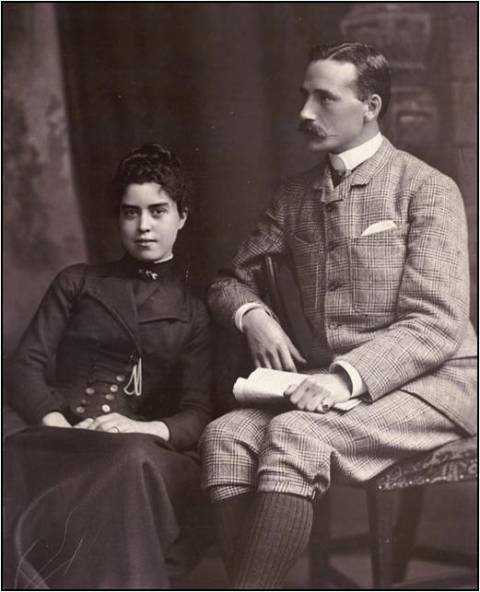
At a ceremony at the Grangepans site on Saturday, 7th March 1891, the first sod was cut by
Mrs Henry Cadell (pictured right with her husband). Prior to the ceremony, the respected lady
was presented with a valuable spade which was inscribed ...
Presented to Mrs H M Cadell, of Grange, by Mr R Simpson, architect,
on behalf of the contractors for erecting the works, on her breaking
the ground, for the formation of the Boness Industrial Co-operative Pottery
and Manufacturing Society (Limited). Boness, 7th March 1891.
The half-yearly general meeting on Saturday, 8th August 1891, held in the Coffee House, Boness, (pictured below as it is today)
attracted a large number of shareholders and delegates. They heard that the construction of the works was behind schedule but it was
hoped to begin full operations about the New Year.
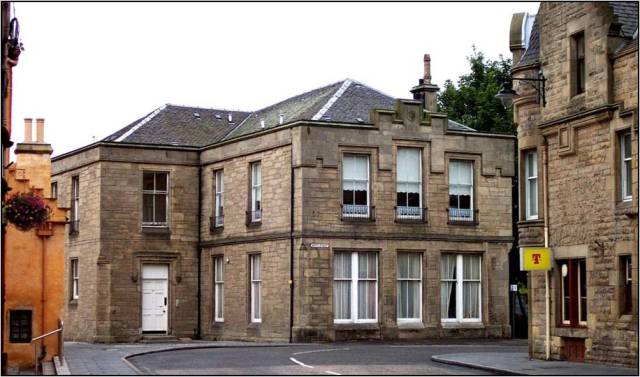
Limited production at the pottery began in October 1891.
On Saturday, 16th January 1892, all the directors and officials and a number of the public gathered at the pottery to watch John
Marshall, the company secretary, formally turn on the steam at the large engine. Afterwards, Mr Marshall held a dinner for the directors.

The official opening was Saturday, 5th March 1892. Unfortunately, James Borrowman, Chairman of the
pottery company, was unable to attend and perform the opening ceremony due to illness.
Mr William Maxwell (left), Chairman of the Scottish Co-operative Wholesale Society, deputised at the
ceremony.
A memorial stone was laid, in the cavity of which was a jar containing documents narrating the various
incidents that led to the erection of the pottery and copies of leading daily and local newspapers. Once
the formalities were finished, dinner was served in one of the warehouses.
James Borrowman died three months later (9th June) at his home, 58 Pollok St., Glasgow.
By August 1892 the pottery was very busy, with orders plentiful from societies and the open market and several extensions with new
tubs and jollies had been added.
At the half-yearly general meeting of Saturday, 20th August 1892, held in the pottery, it was announced that there had been an increase
in share capital of £1,400 and that the works had still to reach full productive capacity. William Maxwell, who had opened the works in
March, was presented with a set of vases as a memento of the opening ceremony.
5 months later, at a meeting of the shareholders on Saturday, 21st January 1893, the balance sheet showed a deficit of about £700 for
the previous six months. A report as to the valuation of the works was also submitted, which showed a difference of £1,394 between
the actual cost and the estimated value of the works. The directors blamed their lack of success to the small amount of share capital
subscribed. This amounted to £7,033, whilst the Societys liabilities were £17,756.
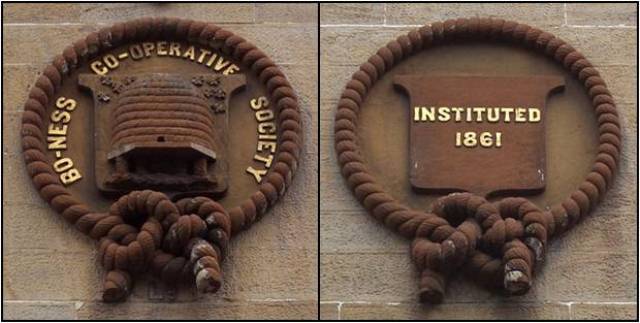
Scottish Wholesale Society delegates stated that if two-thirds more capital
was subscribed, they would increase their societys shares in the concern
by £1,000. Boness Co-operative Society promised a loan of £500 but only
on condition that £4,000 additional capital was subscribed.
At a shareholders meeting on Saturday, 4th February 1893, the secretary
reported that £3,595 had been raised by share capital and promises.
However, this was less than the £4,000 minimum figure that some societies
had insisted on before they released their promises.
On Saturday, 25th March 1893, a special meeting of the SCWS was held in Glasgow and delegates voted 307 to 44 in favour of giving a
£1,000 loan to the pottery society.
At the end of March, Martin Brothers (Ltd.), Plymouth, presented a petition to the Sheriff against the pottery seeking for the society to
be wound up and an official liquidator appointed. Martin Brothers were owed £117 9s 3d.
On a more encouraging note, the press announced in May that the pottery had been the first in Scotland to adopt a new method of
enamelling their wares. This method produced wares with one firing less than the ordinary method and so saved time and money.
These wares were manufactured in ivory vellum and terra cotta colours. They resembled Doulton ware, had proved popular in the
market and as a result, the works were busily employed.
At the half-yearly general meeting on Saturday, 19th August 1893, around 90 delegates and shareholders heard that the volume of trade
had considerably increased in the last 6 months.
However, there was still a need for capital.
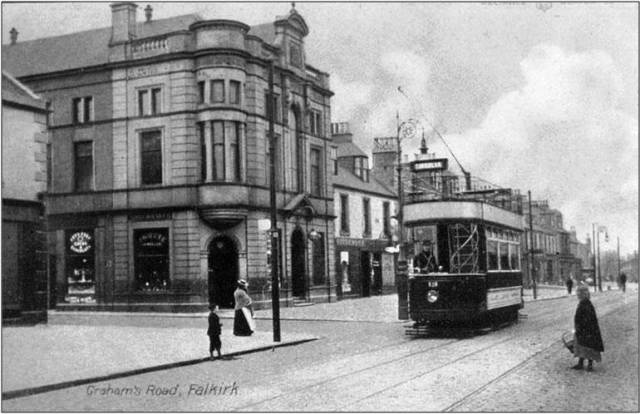
On Saturday, 4th November 1893, a special general meeting of the
shareholders was held in the Oddfellows Hall, Falkirk (left). They heard
that the pottery was still in financial straits. This was attributed to the
expensive machinery and buildings combined with the lack of share
capital. Two recommendations were proposed by the board of
managers and after considerable discussion a large majority agreed to
their adoption:
1. Share values be reduced by 50 per cent
2. Mr John Grieve, late of the Saracen Pottery, Glasgow, be
appointed general manager.
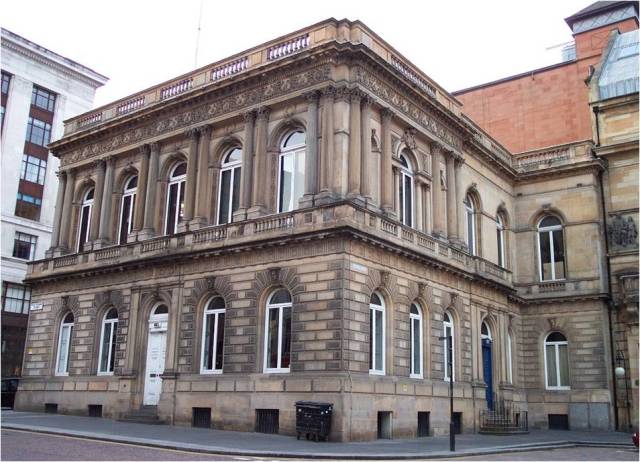
These changes may have made a difference if they had been
given time, however ...
In January 1894, a petition was presented to the Sheriff at
Linlithgow asking for the company to be wound up. This was
done in February 1894 and liquidators were appointed. As a
result, 95 people lost their jobs.
At the most, there was just over two years of production.
The accounts of the Scottish Co-operative Wholesale Society
showed that this pottery venture had resulted in society losses
of £500 in 1893 and £1,493 13s. 3d. in 1894.
In May 1894, the pottery was put up for sale by public roup at
the Faculty Hall, Glasgow.
Faculty Hall, 12 St Georges Place address at time of roup
(Nelson Mandela Place since 16th June 1986)
Notice of the roup appeared in the 5th May 1984 edition of The Scotsman:
POTTERY FOR SALE
There will be Exposed to Public Roup, within the Faculty Hall, Glasgow, on Wednesday the 9th day of May 1894, at 3 oclock P.M. (by
instructions of Edward Peterkin, Solicitor, Linlithgow, Official Liquidator of the Industrial and Co-operative Pottery Society, Limited,
Boness).
That Substantially-built POTTERY in GRANGEPANS, BONESS, which was built about three years ago, and which contains:-
A Single Guide Steam Engine (high pressure), 60 h.p., 6 feet stroke, 14 feet flywheel: a Double-flued Boiler, 100 upright tubes. Mill
House, with 4 Grinding Pans, 4 Colour Mills, and all necessary tanks and appliances. Slip House, with 3 Iron Plungers, Large Pug Mill,
4 Pumps, Clay Hoist, and necessary tanks. Jolly Shop, with 8 Jollies, 4 Jiggers, 2 Batting Machines and 10 Hezagon Stoves, the
whole being heated by exhaust steam from engine. Throwing and Turning Shop, with 2 Throwers Wheels, with Stove Accommodation,
and 18 Turning-Lathes. Bisque Warehouse and Printing Shop, with 2 Steam Stoves, and 4 Printing Presses, and Ample Storage
Accommodation. Large and Commodious Warehouse. Two Bisque Kilns, 16 feet each: 2 Gloss Kilns, 14 feet each. Seggar House,
Green House, Dipping House, Fritt Furnace.
The Machinery and Plant are all nearly new, and are of the most modern description.
The Works are most conveniently situated, having a Railway Siding into them, and are within 500 yards of a Colliery. They are nearly
midway between Boness and Bridgeness Harbours, both being only a few minutes walk distant, which admits of materials being landed
at small cost.
The Works are capable of doing a large trade, are there is provision for future extension.
Upset Price (which has been purposely made low to insure competition), £7,500.
Present Feu-duty, £27,15s.
For further particulars, apply to the SUBSCRIBER, with whom are the Title-Deeds and Articles of Roup; or to CHRYSTAL & MORRIS,
Solicitors, Stirling.
EDWARD PETERKIN, Solicitor, Linlithgow,
Official Liquidator.
The sale was unsuccessful, and by July
..
DESIRABLE POTTERY FOR SALE
There will be exposed to PUBLIC ROUP, within the Faculty Hall, Glasgow, on Wednesday, 8th August 1894, at Three oclock P.M. (by
instructions of Edward Peterkin, Solicitor, Linlithgow, Official Liquidator of the Industrial and Co-operative Pottery Society, Limited,
Boness).
That SUBSTANTIALLY-BUILT POTTERY in GRANGEPANS, BONESS, erected about three years ago, and containing a Large
Quantity of Well-adapted Machinery of the most modern description.
The Works have a Railway Siding and are about 500 yards from a Colliery, and within a few minutes walk of Boness and Bridgeness
harbours, thus greatly reducing the cost of carriage.
REDUCED UPSET PRICE
(which has been purposely made low to ensure a Sale),
£6,000.
Present Feu-duty, £27,15s.
For further particulars apply to the Subscribers, with the latter of whom are the Title-Deeds and Articles of Roup.
CHRYSTAL & MORRIS, Solicitors, Stirling.
EDWARD PETERKIN, Solicitor, Linlithgow,
Official Liquidator.
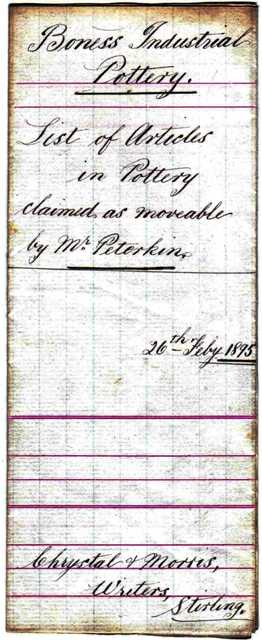
The reduced Upset Price had not ensured a sale and on 26th February 1895,
the Official Liquidator, Mr Peterkin, prepared this List of Articles in Pottery
claimed as moveable.
These moveable items consisted of:
0004 Printing Presses
3500 Seggars
0009 Seggar Drums
0024 Machine Clothes
0031 Stools
0003 Printers Tables
0011 Wooden Tresses
0002 Pair Kiln Steps
0001 Block & Tackle
0010 Baskets
0001 Beam & Scales & Weights
0000 Moulds
0000 and were valued at £45 13s 6d
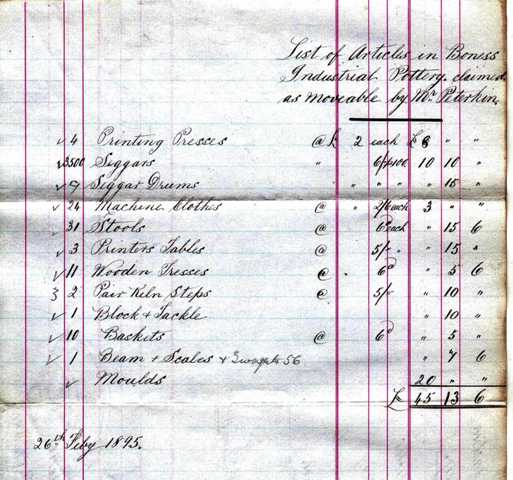
A larger image of this list can be viewed here
The pottery remained on the market until December 1895, when the following reports appeared in the press:
The Scotsman, December 9th, 1895. SALE OF BONESS POTTERY The pottery started several years ago at Boness by a Co-
operative Company has been purchased by Mr James Hutton of the Culross Coal Company. It is understood that the works originally
cost about £13,000, and the price paid by Mr Hutton is believed to be £3,000.
Boness Journal, December 14th, 1895. The industrial pottery at Grangepans, the Boness Co-operative Pottery Society, was sold this
week to Mr. James Hutton of Culross Coal Society for £4000, after it had lain idle for some years. Work was hoped to commence at the
pottery as soon as possible.